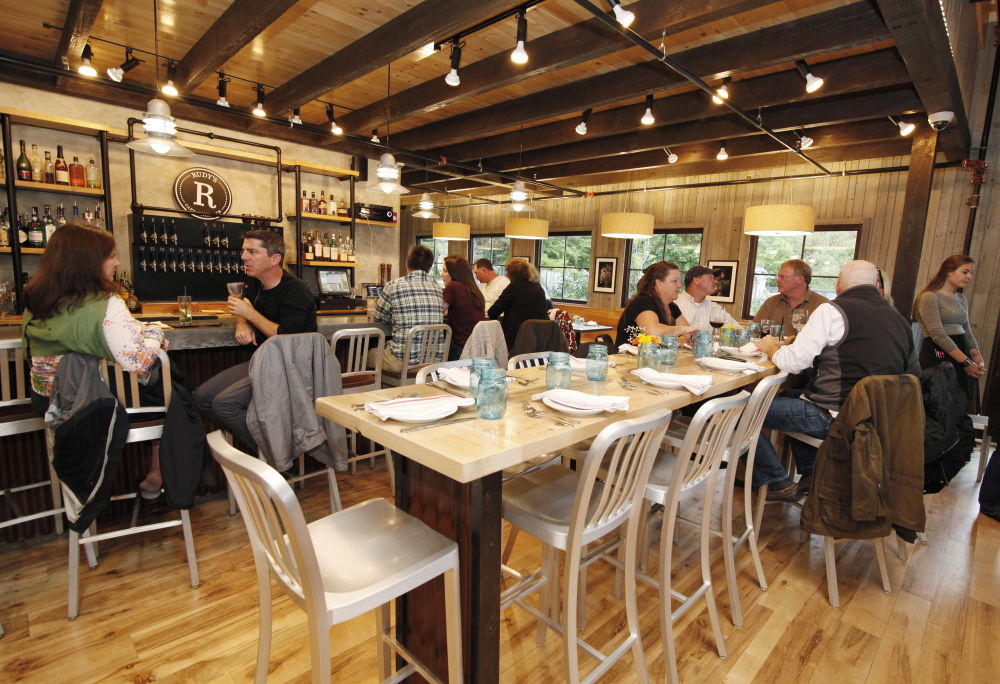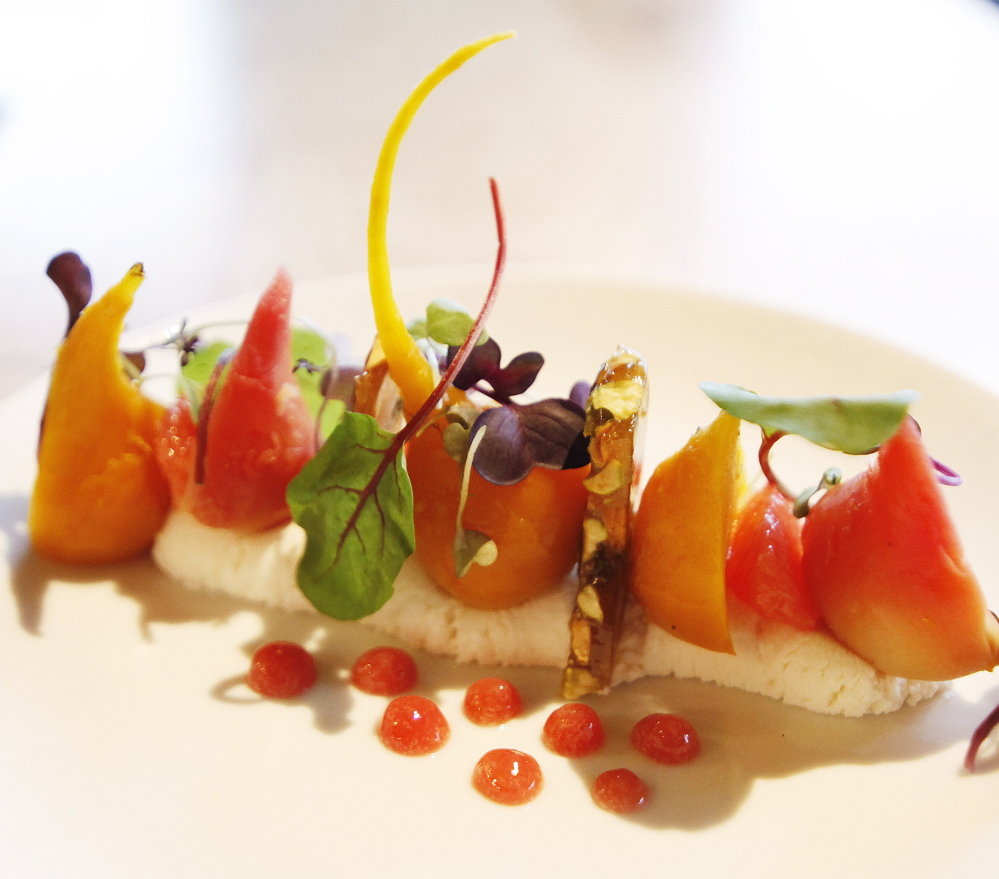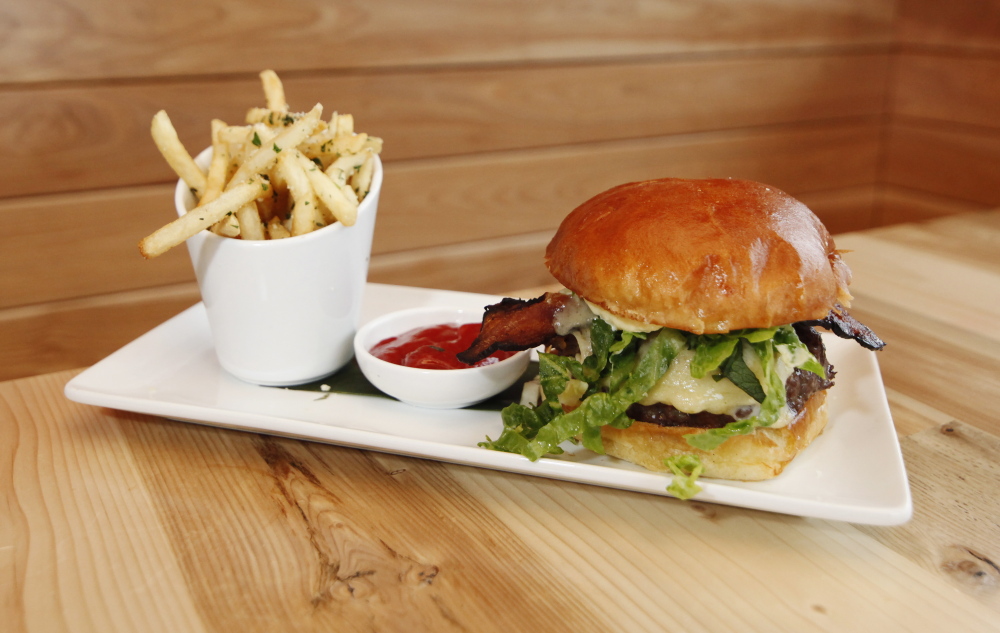Mainers have a natural resistance to change. They repair when possible, reuse when profitable and replace only as a last resort. (Look in your closet and answer one question: How old is that pair of Bean boots in the corner?)
So Paul Woods took a risk when he purchased Rudy’s of the Cape, a much-loved convenience-store-turned-restaurant in Cape Elizabeth, and demolished the old eatery to build an entirely different Rudy’s. What would the stalwart patrons think? Would they come back? Could a new Rudy’s attract a new and equally dedicated clientele?
Based on the number of cars in the parking lot when I drove up last week, the risk paid off. The re-imagined restaurant fills a bright, contemporary building designed by Kaplan Thompson Architects of Portland, and features an enormous pizza oven inside the front door, a dining room divided into distinct seating areas (including a sun room tricked out with snazzy ceiling fans and a modern cast-iron stove) and seats for about 80 customers.
The menu has been thoroughly re-imagined too, with a blend of casual favorites (pizza and burgers), up-market entrees such as yellow fin tuna with toasted nori, and a few showy sides like “toasted fregola” (a pearl-like pasta from the Mediterranean) and “spring-dug parsnip puree with cider-poached cranberry.”
Rudy’s website embraces alliteration and describes the food as “creative cuisine you crave,” but that may be overstating things. The cooking is largely conventional: It’s the atmosphere and the aesthetics that triumph here.
Everything at Rudy’s looks pretty, including the wine goblets (monogrammed with a bold capital R), the bright tiled walls of the open kitchen, the tables made of old-growth timber reclaimed from the Penobscot River, and the light blue mason jars that serve as vases and water glasses. Our burrata ($12), a fresh cheese made with mozzarella and cream, was also stylishly outfitted: it arrived on a rectangular plate decorated with pickled red onion, a shard of honeycomb and a few slices of white strawberries. Unfortunately, the presentation shined brighter than the food. The burrata was chewy rather than supple on the outside – and the interior lacked the usual luscious, buttery taste.
The fried Brussels sprouts ($6) were better, served on another handsome plate (this time made of rustic, glazed earthenware) and topped with rings of jalapeño and a handful of crushed peanuts. Though the sauce under the Brussels sprouts was made with chili paste, it was flavorful without being fiery (the jalapeños were also pleasantly muted) and the sprouts themselves were delicious – sweet and caramelized and just cooked through.
Having had good luck with the Brussels sprouts, I ordered another vegetable – the shishito peppers ($7) on the snack menu. My bad: I should have focused on the waitress’ description, which was about as tepid as the peppers themselves. Blistered and served with what was described as a black garlic aioli, they had little taste. (The aioli had even less. It was so flavor-free that I had to check the menu to confirm what I was eating.) At least the serving platter was a winner: the long, gray charger looked like a chiseled slab of slate with slightly curved edges.
Judging from the number of parents walking in with infant seats – and the table of four incredibly well-behaved youngsters eating at the table next to us – Rudy’s does a thriving family business. So we followed the kids’ lead and ordered a Popeye pizza ($13) with chicken, spinach, mozzarella and white sauce. All four were oohing and aahing as they chewed, and they had a point. The toppings were tasty – particularly the chicken. The crust wasn’t particularly crispy (despite that impressive oven) but the kids raved at the tender texture, and they had us outnumbered two to one.
Another entrée, chicken thighs with toasted fregola ($21), was the night’s best. The chicken was moist and satisfying and the pasta distinctly nutty and pleasantly grainy. Best of all was the mushroom ragu served with the fregola – a rich and earthy complement so meaty it tasted almost like beef.
By now I was feeling perplexed. Rudy’s was obviously popular, doing a booming business this weeknight with neighbors who’d gathered at the high community table in the dining room and families at the smaller tables in the sun room. The wait staff was polite and congenial, service was speedy and the surroundings were definitely attractive. But what about the food? Maybe I was searching for the wrong thing – cuisine that was “creative” – when the kitchen’s strong suit was comfort?
A return visit for lunch confirmed my suspicions. Clam chowder ($9), the ultimate coastal comfort soup, was elegantly presented in a wide, white bowl with a garnish of vibrant pea shoots and a single, crispy clam. It was salty, smoky and complex. Chunks of potato, celery and bacon complemented the creamy broth, which was thick enough to support that single, impeccably fried clam and the spoon that I balanced on top as a test. Some chowders call for a crumble of oyster crackers to bulk them up, and Rudy’s offers a few on the side, but this winning soup didn’t require supporting players.
The chowder was filling, but when the Rudy’s Burger ($14) arrived, my appetite came roaring back. Tucked into a soft-baked bun with strips of crispy bacon and caramelized onion, the burger was so juicy I needed a smock, and so full of flavor that the horseradish aioli on top was unnecessary. This burger was seriously good.
Few desserts scream tradition more than ice cream sandwiches ($8), so I capped my comfort trifecta by ordering one. It was easily as good as the sandwiches I remember from camp … thin sheets of house-baked brownie encasing a vanilla filling and, best of all, an enthusiastic spoonful of salted caramel sauce underneath for dipping. Creative? Not particularly. Pleasing? Without a doubt.
If you’re looking for highly seasoned, cutting-edge cuisine, Rudy’s probably isn’t the right spot. But if you’re craving comfort and a neighborhood atmosphere – plus a familiar name and attractive surroundings – slip on your Bean boots, head to Two Lights and pull up a chair.
James H. Schwartz has covered food, travel and architecture for The Washington Post, Downeast, Coastal Living and Southern Living magazines for more than 30 years. Long a commuter between Portland and Washington, D.C., he retired from his job as vice president at the National Trust for Historic Preservation in 2013 and relocated to Maine.
Copy the Story LinkSend questions/comments to the editors.





Success. Please wait for the page to reload. If the page does not reload within 5 seconds, please refresh the page.
Enter your email and password to access comments.
Hi, to comment on stories you must . This profile is in addition to your subscription and website login.
Already have a commenting profile? .
Invalid username/password.
Please check your email to confirm and complete your registration.
Only subscribers are eligible to post comments. Please subscribe or login first for digital access. Here’s why.
Use the form below to reset your password. When you've submitted your account email, we will send an email with a reset code.